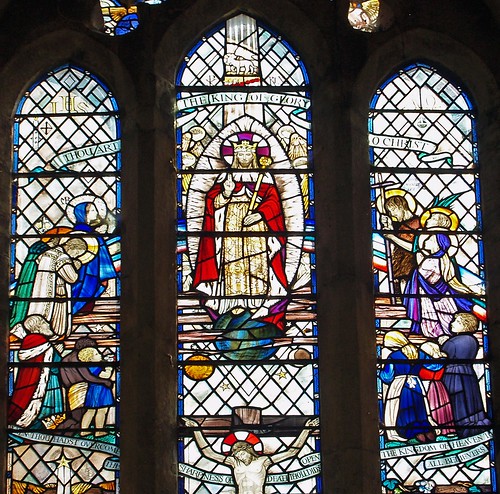ST PETER. Short W tower without spire. Aisleless nave. The steep chancel roof is higher than the nave. The chancel, though it looks all Victorian, is in fact a genuine and fine design of the C13.* This is evident from the chancel arch and the beautiful blank giant arches enclosing the windows, single lancets and triplets of lancets. Externally the buttresses are original too; on both N and S they continue as a framing band at the top of each bay. The nave S doorway is C13 as well. It has one stiff-leaf capital, and the arch starting with broaches. The rest is Perp. - PULPIT. Early C18; plain. - ARCHITECTURAL FRAGMENTS. They include a spiral-fluted Norman column-shaft and a piece of Norman abacus. - PAINTINGS. Large St Christopher (N wall). Note the timber-framed house in the middle distance on the l. Although the painting is of c.1500, the house has the kind of braced panels making concave-sided lozenges which one would not expect before c.1575. - St Anthony and the pig (S wall); unrecognizable. This painting is late C15. - PLATE. Cup and Cover Paten of 1569-70.
* It was demolished and rebuilt in 1884-5.
MOLESWORTH. It has a Yew Tree Farm with timbered walls under a thatch, and a pathetic patch of ground in an orchard where many dogs sleep. Faithful and much-loved creatures they were, among them Tantalising Tommy, who died in Italy. One monument has a bird bath with a stone figure of a terrier.
The church has something to astonish us. The chancel, with angels in its roof, is modern, but the nave and tower are 15th century, and the north and south walls have paintings worth coming far to see. Both were the work of an artist 600 years ago, and though they were fading away when we called we could still see St Christopher and St Anthony. St Christopher is shown with his great stalf and the Child on his shoulder. He wears a white tunic and a red cloak, and is fording a river full of queer fishes, a hermit at the door of what looks like a sentry-box holding a lantern to guide him. Only the lower part of St Anthony’s figure is left, standing among trees with a bell in his hand; jumping up in front of him is a pig with a bell round its neck.
There is an 18th century oak pulpit and an Elizabethan chalice.
The church has something to astonish us. The chancel, with angels in its roof, is modern, but the nave and tower are 15th century, and the north and south walls have paintings worth coming far to see. Both were the work of an artist 600 years ago, and though they were fading away when we called we could still see St Christopher and St Anthony. St Christopher is shown with his great stalf and the Child on his shoulder. He wears a white tunic and a red cloak, and is fording a river full of queer fishes, a hermit at the door of what looks like a sentry-box holding a lantern to guide him. Only the lower part of St Anthony’s figure is left, standing among trees with a bell in his hand; jumping up in front of him is a pig with a bell round its neck.
There is an 18th century oak pulpit and an Elizabethan chalice.



No comments:
Post a Comment